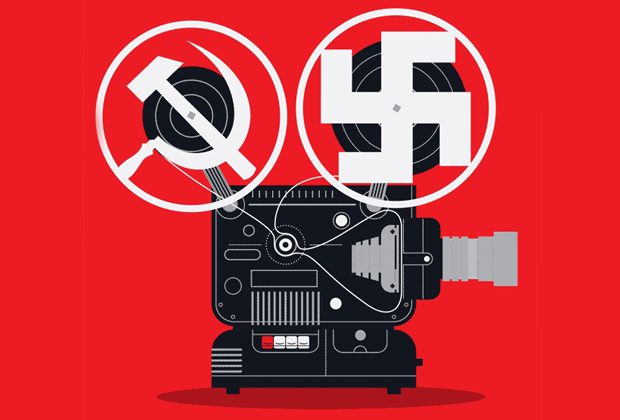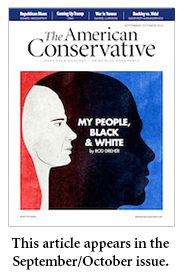How Red Was My Hollywood

Hollywood Traitors reads like a Who’s Who of American Communists. For 500 pages Allan Ryskind lists the names, occupations, and crimes of almost every man or woman ever tainted with support for the USSR in the movie industry. The book is a labor of love. And an exhausting read. It felt like I’d spent several hours flicking through the telephone directory.
Of course, the harder the work then the greater the rewards. This is a book that conservatives will love and which answers a lot of questions. Unfortunately, it also lacks objectivity. This dents its power.
Ryskind’s writing has the obsessive quality of a man out to “correct the record,” and the American right has waited a long time for this. For decades, they say, a line has been spun that McCarthyism was a hysterical rage against nothing at all—that there were few-to-no Communists active in the United States in the 1930s and 1940s and that the “witch hunt” against the radical left was nothing less than American-style fascism. At the center of that popular liberal narrative is the fate of the Hollywood Ten. In 1947, the House Committee on Un-American Activities (HUAC) called witnesses on the subject of Red subversion in the movie industry. Ten writers and directors appeared before the committee but refused to answer its questions, citing their First Amendment rights to free speech and assembly. They had all at some time or other been members of the Communist Party. The Ten were charged with contempt of Congress, found guilty, and sentenced to prison. They were blacklisted from working in Hollywood, along with many other entertainment professionals who were considered fellow travelers.
Ryskind—the son of screenwriter and socialist-turned-anticommunist Morrie Ryskind, who did cooperate with HUAC—regards everything that happened to these people as just desserts. What troubles his conscience is the fact that the Hollywood Ten were eventually forgiven by their industry and their crimes forgotten.
“Hollywood cannot get enough,” he asserts, “of celebrating the ‘victims’ of those 1947 hearings in movies, plays, books, documentaries, skits, oral histories, and public events.” These words are found in Chapter 1, and they are the first warning sign that Ryskind’s book goes too far. For proof of Hollywood’s obsessive liberal forgiveness for Communist crimes he mentions one sympathetic gala at the Academy of Motion Picture Arts and Sciences in 1997, one movie featuring Woody Allen, and one movie starring Jim Carrey. Is that all that there is? I don’t dispute that Ryskind is right that there are many literate Hollywood liberals who do regard the 1940s as a period of “cultural holocaust” for their industry, in the words of movie writer Patrick McGilligan. George Clooney and the cast of “Good Night, and Good Luck” spring to mind. But the idea that Hollywood as a community “cannot get enough” of celebrating the Hollywood Ten is a stretch. I’ve lived in Hollywood. What they can’t get enough of over there is flattery and cocaine. For them history begins at “Jaws.”
Nevertheless, Ryskind succeeds in three regards. First, he conclusively proves that each of the Ten was guilty of having been a Communist at some stage and that the degree of Communist subversion of Hollywood was substantial. The lying was extraordinary. In the case of the writer Lillian Hellman, it lasted a lifetime: obfuscating the details of her support for Communism until her death and, along the way, gaining plaudits for her supposedly noble resistance to false charges. Entertainment professionals joined cells so secret that each could operate quite separately from the others. These men and women put into their movies Marxist messages ranging from the subtle to the overt. MGM’s 1944 film “Song of Russia” stars Robert Taylor as an American conductor who visits the USSR in 1941. His love affair with a beautiful pianist in a surprisingly prosperous socialist republic is ruined by Operation Barbarossa. Ayn Rand, testifying before HUAC, described the Nazi invasion as depicted in “Song of Russia.” Border guards are shown listening peacefully to a Tchaikovsky concert:
Suddenly there is a Nazi attack on them. The poor, sweet Russians are unprepared. Now realize—and that was a great shock to me—that the border that was being shown was the border of [Soviet-occupied] Poland. That was the border of an occupied, destroyed, enslaved county which Hitler and Stalin destroyed together. That was the border being shown to us—just a happy place with people listening to music.
Ryskind’s second success is to remind us of the moral ghastliness of the Nazi-Soviet pact. One of the frequent excuses made for Communist sympathy in the 1930s is that it was a form of opposition to fascism. Yet between 1939 and 1941, Stalin carved up Eastern Europe with Hitler, allowing the German dictator to wage war uninterrupted in the West. Ryskind shows how faithful Soviet agents fell in line, switching overnight from advocating an anti-fascist front to urging America to stay out of the war. It is upsetting to see included on the list of guilty people the names of some the century’s greatest writers: “Lillian Hellman, Donald Ogden Stewart, Langston Hughes, Dashiell Hammett, and Erskine Caldwell backed [the antiwar effort], which savaged the parties resisting Hitler and the nations overwhelmed by his armies as ‘imperialist’. Caldwell, author of Tobacco Road and God’s Little Acre, sent greetings from Moscow.”
But Hollywood did fight back, and Ryskind’s third achievement is to revive some of the reputations of the red baiters. Enter Ronald Reagan. He was a transformative president of the Screen Actors Guild in the 1940s and 1950s. Reagan was a liberal in transition to conservatism, and he navigated Hollywood’s complex politics with intelligence and skill. His goal was to preserve the principles of fair union representation without succumbing to left-wing agitation. Ryskind is at his most revealing when detailing meetings between union activists and stars like Reagan, Gene Kelly, Dick Powell, and Robert Taylor.
Their engagement was partly motivated by self-interest and protecting their industry. But it was also a hangover of the idealism of the 1930s, when the New Deal spirit permeated Hollywood and encouraged unionization. Reagan always remained romantic about the Roosevelt years. There’s a strain of postwar conservatism that was about rescuing liberalism from itself by cutting out the socialism.
Indeed, there’s one interesting detail that Ryskind doesn’t mention about Reagan. Not only was he a New Dealer but in 1945 he spoke at a rally against nuclear weapons. Of course, this does not mean that Reagan was one of those secret Reds that Hollywood Traitors works so hard to expose. But it does remind us that the 1930s and 1940s were a complex time in which many reasonable folks flirted with the left. Ryskind doesn’t give us this kind of social context. 
It’s not that he is unfair with individual biographies: Hayden’s noble war record is covered. But if you flip to the index you’ll note that Ryskind doesn’t include a single reference for the words “Great Depression.” This is a major omission in a book about U.S. communism. Ryskind does not talk about breadlines or mass unemployment. Anti-Semitism isn’t touched upon much either, despite Hollywood being a town in which aspiring immigrant Americans found themselves blackballed from the best clubs and schools, which was bound to breed some resentment against the establishment. Nor does Ryskind expose the ruthless conservatism of the studio system, which did its best to destroy unions and whip its stars into political order. When Upton Sinclair launched a progressive campaign for governor of California in 1934, MGM docked its employees a day’s pay to donate to the opposition. Stars who refused to join the bandwagon were punished. The movie moguls were savage gods who ran their studios like factory lines.
And they sexually abused the staff. Louis B. Mayer—fine Republican, personal friend of Herbert Hoover, and described in Hollywood Traitors as “typical of the success story of so many American immigrants”—invited Judy Garland to sing for him in his private office while he groped her left breast. “I often thought I was lucky I didn’t sing from another part of my anatomy,” Garland later joked.
Incidentally, Mayer was indeed happy to blacklist Communists in his studio. But he was less happy about the thought of federal legislation doing it for him. In Hollywood Left and Right, Steven J. Ross explains that Mayer and Warner Bros were not pleased with Washington meddling in their affairs. “Despite his vocal anti-Communism, Mayer initially resisted firing anyone who could make money for his studio.” A screenwriter under suspicion was brought to Mayer’s office, and the mogul told him: “I don’t give a s–t about the law. It’s them goddam commies that you’re tied up with. Break with them … I believe you’re great. Dough means nothing. We’ll tear up your contract, double your salary. You name it, you can have it. Just make the break.”
The screenwriter refused. Ross puts Mayer’s intervention down to financial interest. But it’s impossible not to read between the lines of that dialogue and sense that the studio boss was genuinely keen to save a good artist from his own damned foolishness.
The point is that the politics and the emotion of the period were more ambiguous than a straightforward fight between good (America) and evil (lying Commies). Hollywood was dealing with issues of class, race, identity, and the tension between liberty and patriotism. And it is possible to stand back from this whole messy narrative and grasp that, yes, the Hollywood Ten were Communists, fools, and/or liars—but there’s still something disturbing about the way they were treated in a society predicated upon political liberty. Can a free society tolerate the freedom of people who want to abolish freedom? Increasingly, Western societies are now saying “no.” My own country, Britain, is on the verge of asking teachers to watch their pupils for evidence of “extremism”—homophobia qualifies—and report it to the authorities. We are in danger of replaying McCarthyism like it’s a special season of paranoia on Turner Classic Movies.
Ryskind’s book brings a lot that’s fresh to this subject—but not quite enough. He’s very good at identifying the way in which left-wing authoritarians eradicate disagreement. He’s less keen to acknowledge the sins of the right. McCarthyism was on many levels a quite rational response to social change and political threat from a foreign power. But it was undeniably also used to retard the growth of the New Deal project and repress the liberal spirit of the 1930s. It was as American as vodka and the balalaika.
Timothy Stanley is the author of Citizen Hollywood: How the Collaboration between LA and D.C. Revolutionized American Politics.
Comments